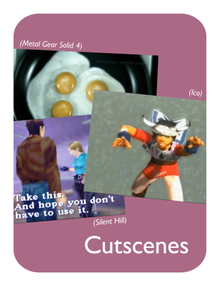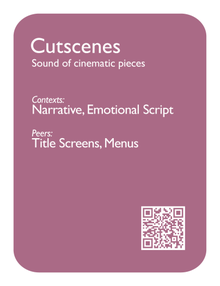Difference between revisions of "Cutscenes"
ValterAlves (Talk | contribs) m |
ValterAlves (Talk | contribs) m |
||
| Line 6: | Line 6: | ||
| patternpresentation = | | patternpresentation = | ||
| cardpresentation= | | cardpresentation= | ||
| − | | v10frontface = | + | | v10frontface =Cut-Scenes-front-v10.png |
| − | | v10backface = | + | | v10backface =Cut-Scenes-back-v10.png |
| v20frontface =Cutscenes-front-v20.png | | v20frontface =Cutscenes-front-v20.png | ||
| v20backface =Cutscenes-back-v20.png | | v20backface =Cutscenes-back-v20.png | ||
Revision as of 20:39, 21 November 2011

|

| |
| The card's front face | The card's back face |
Synopsis
| Sound of cinematic pieces. |
Relationships
Contexts:
Narrative ![]() , Emotional Script
, Emotional Script ![]() .
.
Peers:
Title Screens ![]() , Menus
, Menus ![]() .
.
Description
In their typical form, Cut-Scenes are cinematic parts of the game inserted between moments of Gameplay. They usually serve the Narrative, and do so in a way that has strong impact in the Emotional Script.
Being static pieces, they are prone to incorporate more closely techniques from film practice, including in terms of the approach to sound. Still, considering the pertinence in keeping the whole product coherent, for instance regarding the Acoustic Ecology, it is relevant that they are considered holistically, in conjunction with the others components of the game (Sound Places) – that is, the Gameplay but also the Menus and even the Title Screens.
It is worth noticing that some modern games include interactive Cut-Scenes, which present new opportunities and challenges, closer to those of regular Gameplay.
What is more, there is controversy regarding the appropriateness of Cut-Scenes in video games. Some designers defend they are disruptive and compromise immersion, for instance. [pending: Develop this further in 'Additional Comments'].
Examples
Additional Comments
[pending: Elaborate on the controversy about the appropriateness of Cut-Scenes in video games.]







